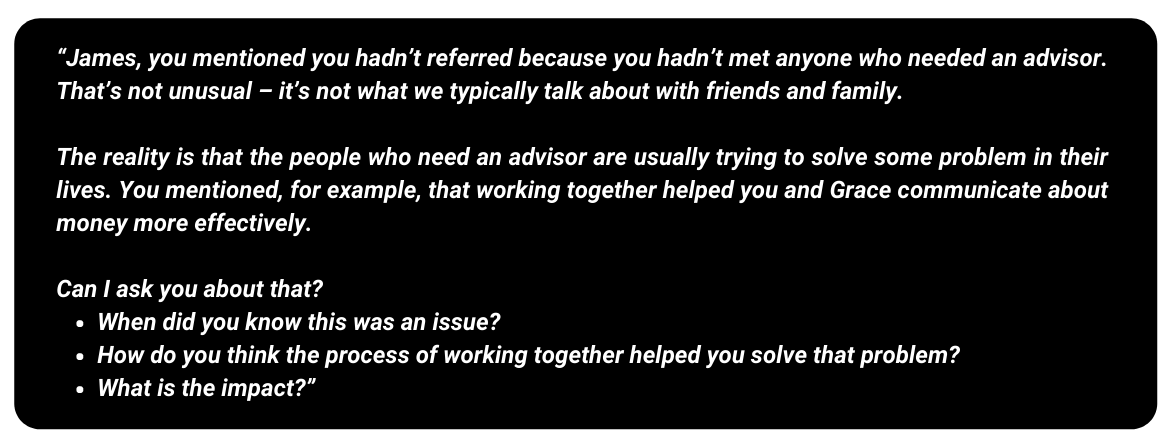We all know that stories are incredibly powerful and that’s particularly true when it comes to articulating your value.
It’s also true that stories can support your referral efforts because they are shared more easily and readily.
Stories are:
- Meaningful because they can be told through the eyes of the client and focus on the problems you solve (rather than your technical expertise).
- Memorable because they are remembered more accurately and longer than facts and reflect how most people learn.
- Shareable because they reflect how we already communicate with friends and family.
So what does this mean for your referral efforts?
It’s a reminder that when clients share stories about the impact you have had, it’s not only easier for them to share but more impactful for prospects.
And that means that a referral is more likely to lead to a successful introduction.
There are two types of stories to consider.
- The stories clients share about their own experience in working with you.
- The stories clients share about the experience of others who have worked with you.
At one level you might ask why we have to worry about clients sharing their own story. It’s their story, after all. And while there is some truth to that, there is much we can do to help clients:
- Remember the details of their story
- Articulate their story
- Share their story
A Case in Point
We worked recently with an advisory firm with a relatively simple goal - to increase referrals.
In fact, after gathering input from their clients we discovered that they didn’t need to increase referrals at all. Rather, they needed to increase the percentage of existing referrals that became introductions. I’ll bet the same is true for your business. But I digress.
We asked clients to share input on their past referral behavior and also to identify the impact that working with their advisor had had on their lives. The results varied, of course, from one client to the next. Common themes did, however, emerge.
Those themes were interesting on their own, but here is how our client used those results in the form of a sample client conversation.

By asking the client to share their story and by doing that with three specific questions, something important happened.
The clients started to write their own referral scripts.
The Elements of a Shareable Story
Each of the three questions in our example had an intentional purpose.
When did you know this was an issue?
By articulating this, the client identified a specific ‘trigger’. In this example it could be that the couple found themselves arguing about money. Now when your client hears a similar issue raised by a friend, he/she will likely share this story.
How do you think the process of working together helped you solve that problem?
By answering this question, the client honed in on the specific aspects of the work that were particularly helpful. It maybe an exercise you took the couple through, a conversation you had or a resource you shared.
What is the impact?
By answering this question the client reinforced the advisor’s value in their own mind.
Simply by answering these three questions, clients were writing their own story, but with a structure that made it shareable. As a result they:
- Were more likely to think of their advisor when they heard a similar problem expressed.
- Could recall how the advisor helped them in a way that may be helpful for their friend.
- Could clearly articulate the impact.
What if You Don’t Have Direct Input?
Above is a real example of a firm that gathered input. But what if you don’t have that information in advance?
You can still ask questions that will get your clients sharing their story in a way that will help them share more easily and more often. I’ll tackle that next week.
Related: Is Hyper-Personalization the Next Big Thing in Client Communication?
